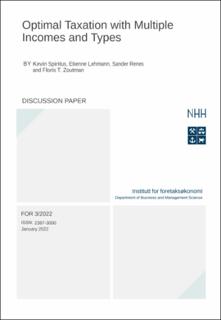| dc.contributor.author | Spiritus, Kevin | |
| dc.contributor.author | Lehmann, Etienne | |
| dc.contributor.author | Renes, Sander | |
| dc.contributor.author | Zoutman, Floris T. | |
| dc.date.accessioned | 2022-01-24T14:07:49Z | |
| dc.date.available | 2022-01-24T14:07:49Z | |
| dc.date.issued | 2022-01-24 | |
| dc.identifier.issn | 2387-3000 | |
| dc.identifier.uri | https://hdl.handle.net/11250/2839009 | |
| dc.description.abstract | We analyze the optimal nonlinear income tax schedule when taxpayers earn multiple in comes and differ along many unobserved dimensions. We derive the necessary conditions for the government’s optimum using both a tax perturbation and a mechanism design approach, and show that both methods produce the same results. Our main contribution is to propose a numerical method to find the optimal tax schedule. Applied to the optimal taxation of couples, we find that optimal isotax curves are very close to linear and parallel. The slope of isotax curves is strongly affected by the relative tax-elasticity of male and female income. We make several additional contributions, including a test for Pareto efficiency and a condition on primitives that ensures the government’s necessary conditions are sufficient and the solution to the problem is unique. | en_US |
| dc.language.iso | eng | en_US |
| dc.publisher | FOR | en_US |
| dc.relation.ispartofseries | Discussion paper;3/22 | |
| dc.subject | Nonlinear Optimal Taxation | en_US |
| dc.subject | Multidimensional Screening | en_US |
| dc.subject | Household Income Taxation | en_US |
| dc.title | Optimal Taxation with Multiple Incomes and Types | en_US |
| dc.type | Working paper | en_US |
| dc.source.pagenumber | 54 | en_US |
